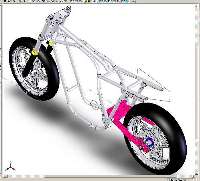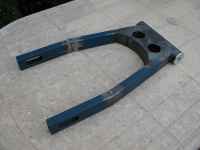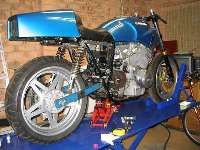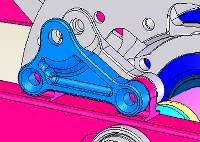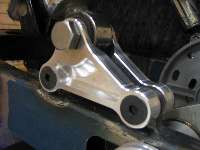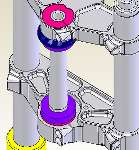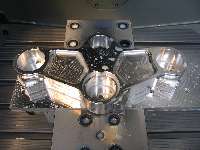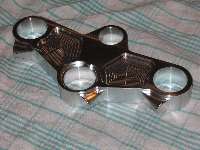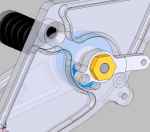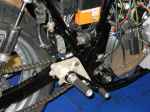CHASSIS UPGRADE
Overview: Stiffened frame, custom swingarm, large diameter hollow axles, Astralite wheels (18x3.5 front, 18x4.5 rear), 42mm Forcelle Italia forks, 320mm floating Brembo brakes,custom triple clamps & spindle, 'modernise' steering geometry to 26deg rake and 100mm trail.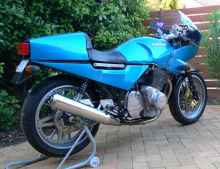
This is the bike my Dad bought new in 1985, and which I bought from him in 1992 when I was 20. Some years back a small bit of work on the engine snowballed into a complete top end upgrade, punching it out to 1130, getting 4C cams, a worked head, big exhaust and so on. Later came an IIS ignition, Axtell cams, and Mikuni CV carbs. The motor went really well and I soon started to see the shortcomings of what was now an overstretched chassis- the bike exhibiting some interesting weaves and wallows when the going got tough.
My good mate Thomas Hauge thought he would help me out by throwing the #2 conrod out of his Mirage special, and decided to part the bike out - a great shame which I tried to talk him out of. But he was resolute so I bought all the good chassis bits- Astralite wheels, Forcelle Italia 42mm forks, and lovely Brembo billet brakes. The chassis upgrade had begun...
Next up was improving the frame. Many people have trod this path before (thanks Thomas Hauge, Sander Habets, Chris Pritt & others) so I was able to base my modifications on what the factory and various owners have done over the years. I worked on improving the stiffness of the frame in three main areas; steering head, swingarm pivot and the link between the triple spine tubes and swingarm pivot.
I made up a stepped
punch to mark the new diameter of the pivot holes, which were laboriously
filed out (the factory plate is 10.5mm thick here!!), then reamed to final
size (using a guide through the hole in the other side) until a stepped
bush was a knock-in fit. This procedure was then repeated on the other
side and the bushes jigged together in alignment. Thin sheet was fabricated
to box the whole structure together, the whole lot TIG welded up and after
all welding was completed the bushes - machined slightly undersize - were
reamed to finish size (once again using the opposite side as a guide)
thereby retaining perfect alignment. The new 20mm hollow spindle is now
a perfect sliding fit through both holes.
Looking at the structure of the frame, it is obvious there is an open
square between the outer spine tubes and the swingarm pivot. When the
swingarm pivot is trying to twist itself in relation to the headstock,
the frame has no triangulation in this point. I wanted to feed the forces
from the swingarm pivot more directly to the large triple-spine tubes,
so I fabricated a diagonal brace from the top of the new boxed-in pivot
plates to near the seat rail attachment point. I knew at the time this
would mean the original air box would not fit (no problem, my Mikuni one
would have), and even back then I had a sinking feeling I was probably
going a bit overboard here. Not sure if I would do the diagonal brace
again, it does greatly reduce the space available for fitting the EFI
components. Mind you, the bike now handles perfectly, so who's to say
how much the diagonal brace is contributing to that?
 |
 |
 |
 |
 |
 |
 |
 |
 |
 |
 |
 |
When turning to the
steering head, I based my modifications on the factory bracing kit from
the 80's and worked from there. Looking at modern sportsbikes, they have
a larger diameter bottom steering head bearing, and a tapered spindle.
Chris Pritt theorised that part of his weave came from the steering head
spindle flexing, some claim to have cracked their spindles, though I suspect
this may be more to do with accident damage.
I knew that with the ride height I intended to use I would have a little
bit of space left between the fork slider and the bottom triple clamp
at full compression, I wanted to reduce this to near-zero as it means
the forks are not hanging out unsupported as much. So there was just room
to fit an extension bush into the headstock, to accept a 32005 bearing
which has a 30mm ID, up 5mm on the original, allowing for a stiffer steering
spindle.
When the paint was stripped I found that the frame (a one-owner never
crashed bike) was cracked in the 'normal' place where the downtubes meet
the steering head, it's clear that the downtubes must be flexing for those
cracks to arrive. Once again standing back and looking at the structure,
I worked on providing a path for the forces at the lower steering head
bearing to be fed into the downtubes and outer spine tubes - basically
tying that whole area of the frame together into a single unit. This worked
in well with my extended steering head housing, as the gussets on that
neatly triangulated down to the outer spine tube / down tube joint. I
also added the extra tube above the headers, as per the factory bracing
kit.
 |
 |
 |
Growing tired of welder's-flash
and holes burnt in my jumper, it was time for some machining jobs. A few
hundred hours of fiddling and changing my mind soon saw a nice design
for triple clamps in front of me on the screen, including a +/-5mm adjustable
offset provision, allowing a little tuning of the trail if required. My
only other motorcycling weakness is for Bimotas, and all the machined
parts I have designed are heavily influenced by those Italian works of
art. Along the way the design got more elaborate, and I included some
pretty funky 3D machining in my design. But first I made a practice out
of the brackets for the rear shocks, these are intended so that I can
make ones of different heights, allowing major changes to the rear ride
height without welding new brackets on the arm all the time. Also for
the "bling" factor 'coz they look cool.
I operated a CNC milling machine almost 15 years ago but technology has
changed completely since then, with after-hours access to a nice new CNC
mill and CAM software I dived into this interesting new world of technology
with instruction from good mate and former Laverda owner Steve H. As a
practice these were great as they're pretty small and incorporated both
relatively simple 2D profiling and also the 3D milled pocket on the outer
faces.
For those not up to date with the lingo in this arena, CAD means computer aided design, CAM means computer aided manufacturing and CNC means computer numeric controlled (machine). The process goes; 1. design your part in CAD, producing a full 3D model, 2. import that model into the CAM software, 3. select and apply appropriate tools to cut the geometry you require, 4. have the CAM software generate the CNC code, 5. transfer the code to the CNC milling machine, 6. set up all the tools required by the program, 7. clamp your workpiece in the machine (often requires making jigs), 8. set up the workpiece's datum points in X,Y and Z, 9. run the program, 10. pray you got it right... the results of even the slightest error can be catastrophic - the machine will happily drive a several hundred dollar carbide cutter into a several thousand dollar hydraulic vice if you tell it to... making lots of very expensive noises in the process...
Over a period of several months the design of the triple clamps was refined. Learning as I went, the CAM process was completed using a lot of trial and error (you can preview the machining operations on the screen), needing to learn not only the software but also how to properly use the amazing tooling for these CNC machines. I ordered in a couple of lumps of 6061-T6 and off we went...
And so that is basically it. I'm very happy with it all and am now moving on to the EFI..... stay tuned.

